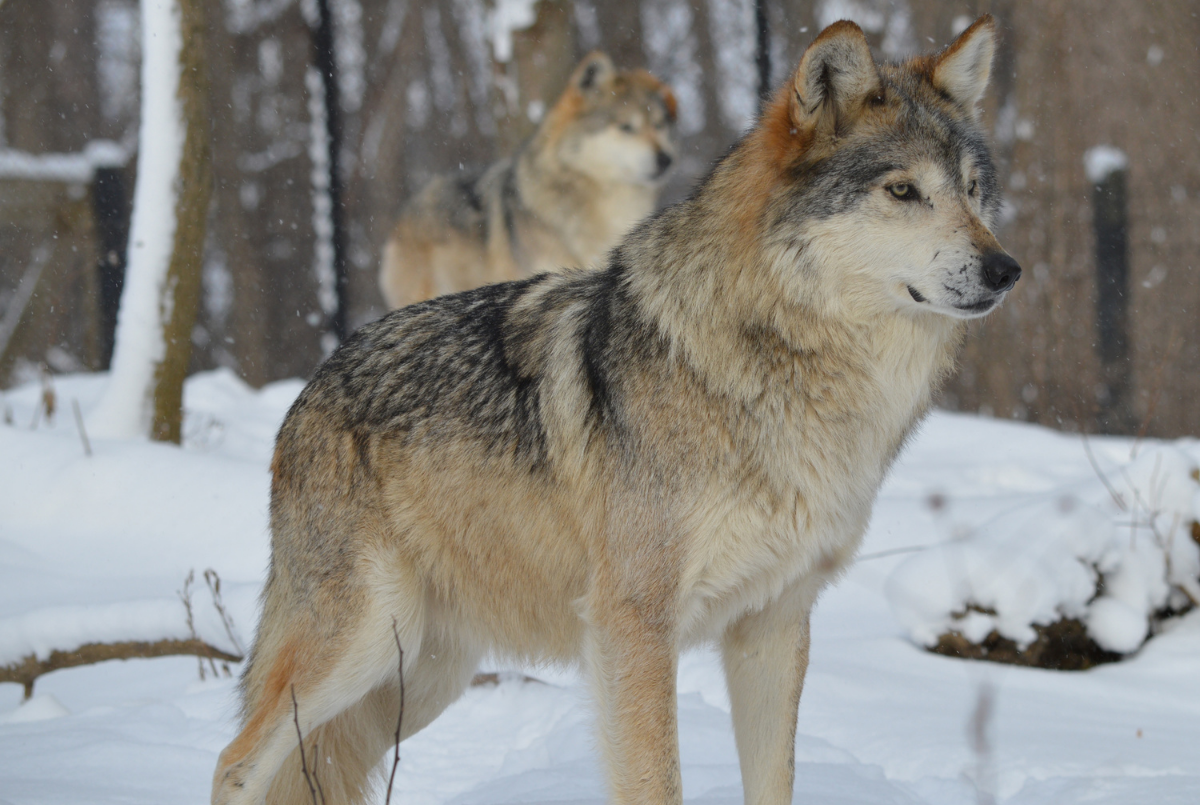Mexican Wolf

Basic Information:
Scientific Name: Canis lupus baileyi
Habitat: Mexican wolves are located in the deserts and mountainous woodlands of Arizona, New Mexico, and parts of Central Mexico.
Diet: Mexican Wolves are predators and eat deer, elk, wild pigs, rabbits, and rodents.
Size: 2 to 2.8 feet tall / 5 to 5.6 feet long
Weight: 50 to 80 pounds
Lifespan: 11 years according to AZA Species Survival Statistics
Distribution Map:
I.U.C.N. Conservation Status:

What does this mean?
Endangered – a species determined by the International Union for Conservation of Nature (I.U.C.N.) to possess a very high risk of extinction as a result of rapid population declines of 50 to more than 70 percent over the previous 10 years (or three generations), a current population size of fewer than 250 individuals, or other factors.
Mexican Wolf SAFE Program:

Saving Animals from Extinction (SAFE) is a program with the goal of using the collective expertise within AZA-accredited zoos and aquariums to save threatened species.
Beginning in the early 1900s, Mexican Wolves were seen as a threat to the livestock of the rapidly expanding population into the American Southwest. To protect their livelihood, local farmers (many times funded by the US government) began trapping, hunting, and poisoning expeditions to eliminate the majestic breed of canine. This was so effective that by 1930, these wolves were almost extinct. And by the 1970s, only 7 wolves were thought to be left alive on the planet. Thankfully, the species was marked as Endangered in 1976 and all 7 wolves were taken into human care and put into breeding programs across various sanctuaries and zoos. Knowing the dire nature of the situation, specialists took up the mission of bringing this species back from the brink. Their mission began by determining which wolves should breed with each other to make the new population as genetically diverse as possible. And finally in Arizona in 1998, the first 11 Mexican wolves were reintroduced into the wild. And now – 25 years later – there are estimated to be 241 wild Mexican wolves in the US with 45 in Mexico, along with another 380 in human care.
Want to learn even more and see ways that you can support Mexican Wolf populations? Click the link below!
Our Mexican Wolves
Fenrir (Male) – Born May 8, 2016
Ah Tabai (Male) – Born May 8, 2016
Maitland (Male) – Born May 8, 2016
About Mexican Wolves:
Despite being the smallest wolf subspecies in North America, Mexican wolves are still extremely important to the southwestern deserts of North America. Dating back to the 14th century, the Aztec empire revered the Mexican wolf. There is evidence of these Pre-Columbian people using these wolves for sacrificial ceremonies, wearing their skulls and pelts as religious clothing, and giving them ritualistic burials in the Templo Mayor (or primary holy building of the Aztec city of Tenochtitlan). According to archaeologists and historians such as Leonardo Lopez, Mexican wolves were related to the Aztec sun and war god Huitzilopochtli and were thought to be spirit guides for warriors in the underworld. In a more modern context, however, Mexican wolves are integral to the stability of their ecosystem. Since they are one of the primary carnivores in the southwestern area, if wolf populations decline then the populations of their primary prey – elk, deer, and wild pigs – will grow exponentially. In turn, this leads to more grazing and a decrease in the balanced floral diversity that keeps their habitat healthy. This is one of the many reasons that huge conservation efforts have been made to keep Mexican wolf populations stable. Throughout the 1900s, these wolves were hunted by farmers in the area out of fear for their livestock. This almost drove these amazing canines to extinction. Thankfully due to breeding and reintroduction programs, wolf numbers are slowly increasing every year. Today, you can find wild Mexican wolves hunting in packs across the Arizonian and Mexican deserts. These packs have complex social structures and are lead by a mated, alpha pair. Together, they work together to run down their prey and – thanks to their effective teamwork – are capable of taking down animals that are substantially larger than they are themselves.
Did You Know?!
- Mexican wolves are the smallest gray wolf subspecies in North America and one of the rarest and most endangered mammals on the continent.
- Wild Mexican wolf populations increased in size by 24% in 2019 but still have a long way to go. Their population size in the wild is only approximately 300 individuals.
- Mexican wolves travel in packs and roam their territories of 30 to 500 square miles together.
- Mexican Wolves have a clearly defined hierarchy within the pack centered around a breeding pair that mates for life. Each spring, the pack’s alpha female gives birth to a litter of pups in a burrowed-out den. She’s the only pack member who has pups, but the whole pack helps raise them by brining food to the den in their own stomachs and regurgitating it for the pups.
- A healthy adult Mexican wolf can survive for days or even weeks without food if they have to.
- Mexican wolves have 42 teeth.
